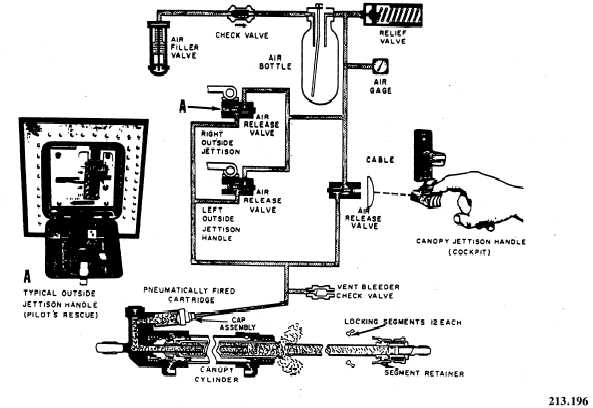using the ejection seat require ejection through
the canopy unless special conditions dictate a
deviation is necessary. In the A-6, a jettison sleeve
is housed in the canopy actuator rod. Passages
within the canopy actuator connect to a jettison
cartridge that is mounted on the side of the
cylinder head end. When the cartridge is fired,
expanding gases create the necessary pressure to
unlock the jettison sleeve from the rod end and
force it and the canopy aft and off the aircraft
(fig. 2-7). The jettison cartridge is fired by
pneumatic pressure from a small (14.6 cu in.) air
bottle pressured with nitrogen to 2,450 psi at 70°F
prior to takeoff.
Three air release valves are installed in the air-
craft for jettisoning the canopy. One valve is
actuated from the cockpit, the other two by their
respective RESCUE handle on the engine intake
air ducts. Opening any one of these valves directs
nitrogen pressure from the bottle to the canopy
actuator cap assembly (fig. 2-7) and fires the
pneumatic jettison cartridge.
To manually release the canopy actuator from
the canopy attachment, pull either of the manual
release handles located under access doors on the
aft end of the canopy shell or the single manual
release handle located on the canopy overhead
center beam.
SYSTEM COMPONENTS
The main components of the canopy jettison
system are shown in figure 2-6. The relief
valve prevents excessive air bottle pressure
increases due to thermal expansion and over-
pressurization during charging. The valve cracks
to relieve pressure at 3,800 psi and reseats at
3,400 psi.
The air gauge provides a means of checking
proper system precharge. The gauge is tapped into
the pressure line between the air bottle and the
cockpit air release valve.
The vent bleeder check valve is located on the
forward side of the left boarding ladder well. The
valve is located downstream of the three air release
valves and vents any low-pressure nitrogen that
may have leaked past the air release valves, thus
preventing inadvertent cartridge actuation. The
vent bleeder check valve is normally open at 40
to 80 psi. When an air release valve is actuated,
the bleeder valve closes and remains closed
throughout the jettison operation. The bleeder
valve will reopen when the pressure in the system
is reduced below 40 psi. The bleeder valve also
has a manual override that permits bleedoff of
nitrogen pressure after jettison system testing as
required during periodic inspections.
Figure 2-7.—Canopy jettison schematic.
2-10


